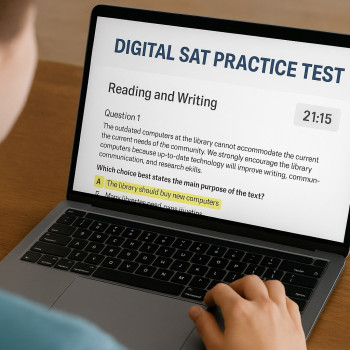Why this guide matters — the gap year and the SAT
Gap years are deeply personal: some students travel, some work, some pursue internships, and some take time to breathe, reflect, and strengthen academic foundations. As a parent, you might wonder where the SAT fits into this year of exploration. The short answer: it can fit in thoughtfully, without stealing the spirit of the gap year. This guide is written for parents who want practical, human-centered ways to support their gap-year student through Digital SAT preparation while protecting the growth, purpose, and flexibility that made them choose a gap year in the first place.

Start with the big picture: goals, deadlines, and motivation
Before you buy practice tests or set a study routine, sit down with your student and map three things: goals, deadlines, and motivation.
1. Clarify college and scholarship goals
Ask which colleges the student is considering, whether test scores will be submitted, and whether certain scholarships require a score threshold. Some colleges are test-optional, but many still accept or consider SAT scores for scholarship opportunities and admissions advantages. Knowing the score target gives structure to the plan.
2. Set realistic deadlines
Because the SAT is fully digital, there are test dates year-round in many locations. Identify any application deadlines (early action, regular decision) and work backwards to find the latest SAT date that allows score reporting in time. Build in a buffer — if a student wants to retake, make sure there’s at least one earlier test date to allow for improvement.
3. Connect with meaningful motivation
Gap year students often respond better to purpose-driven study than to pressure. Explore what motivates them: scholarships, a program requirement, or simply proving to themselves that they can master a subject. When motivation is intrinsic, study becomes purposeful instead of punitive.
Design a flexible study plan that respects the gap year
The most successful plans balance consistency with flexibility. Here’s a model that many parents find helpful: short daily practice, one weekly focused session, and monthly full-length practice exams.
A sample weekly rhythm
- Daily: 30–45 minutes of targeted practice (reading passages, math drills, vocabulary-in-context).
- Weekly: 90–120 minute deep-dive into a weak area with timed sections.
- Monthly: One full, timed digital practice test under realistic conditions (tablet or practice platform), followed by an analysis session.
That rhythm keeps momentum while freeing time for gap-year activities like internships, travel, or community work.
Practical tools and resources to prioritize
Encourage a toolbox that blends official resources, targeted practice, and personalized guidance.
Official practice and diagnostic tests
The most accurate preview of the Digital SAT comes from official practice materials and full practice tests. These give reliable timing, question-types, and score estimates. Parents can help by creating a realistic testing environment for practice days — quiet space, no interruptions, and a simple checklist for test-day items.
Personalized tutoring when it makes sense
Sometimes a student needs structure or expertise beyond self-study. Personalized tutoring — such as Sparkl’s 1-on-1 guidance — can deliver tailored study plans that zero in on weaknesses, offer expert tutors who adapt strategies to the student’s learning style, and provide AI-informed insights to track progress. Consider short, intensive tutoring blocks rather than an open-ended long-term commitment when your student is taking a gap year; this preserves flexibility while delivering high-impact support.
Practice platforms and timed practice
Use platforms that simulate the digital test interface and built-in calculators. The aim is to reduce unfamiliarity on test day: digital navigation, drag-and-drop question types, highlighting text passages, and embedded calculators are part of the new normal.
Study strategies that actually work for gap year students
Not all study techniques are equal. Here are strategies grounded in learning science and practicality.
1. Small, intentional practice beats marathon sessions
Short, focused sessions help retention. Work on one skill per session (e.g., analyzing paired passages, quadratic equations, or data interpretation) and end with a clear micro-goal.
2. Use error logs to make practice efficient
Maintain a simple error log: question type, reason for mistake (timing, careless error, content gap), and a corrective action. Over weeks, patterns emerge and guide what to prioritize.
3. Build test stamina gradually
Digital tests feel different. Build stamina with progressive practice tests: start with half sections, then complete section blocks, then full-length tests. Work up to the official timing and device setup.
4. Mix content review with strategy practice
Content knowledge (algebra, grammar rules, geometry) is necessary but not sufficient. Strategy — how to eliminate wrong answers, when to skip and return, and how to pace each section — is equally important. Tutors or study plans that combine both will accelerate progress.
Table: Suggested timeline for a gap year student planning to apply next fall
| Months Before Application Deadline | Goal | Parent Role |
|---|---|---|
| 9–12 months | Set score target; take diagnostic test; create study rhythm | Help schedule diagnostic test and discuss goals; support consistent daily practice |
| 6–9 months | Focus on weak domains; begin monthly full-length practice tests | Arrange practice test environment; consider short tutoring block if stalled |
| 3–6 months | Polish timing and test strategies; take a realistic practice test every 2–3 weeks | Provide quiet, uninterrupted time for practice; help manage retake logistics |
| 1–3 months | Finalize test date(s); focus on mock tests and error log corrections | Confirm registration and score reporting details; encourage sleep and healthy routine |
| Final 2 weeks | Light review, test-day rehearsal, stress-management | Be supportive and practical — prepare test kit, check travel plans, model calmness |
Test-day logistics: the things parents can check (and calm)
Logistics are low-hanging fruit that parents can reliably manage: registration deadlines, ID requirements, travel to the test center (if required), and a test-day kit. Here’s a simple parent checklist.
- Confirm registration and score-sending preferences well in advance.
- Check ID requirements and bring a backup (student ID, passport).
- Make sure the student has a charged device if taking any practice app that simulates the testing interface (for practice, not the actual test).
- Pack snacks and water for before/after the test. For digital SAT, follow rules about what’s allowed into the testing space.
- Plan travel time with extra buffer; identify parking and test-center entry procedures.
Emotional support and wellbeing: parent-as-coach, not commander
Preparation isn’t only cognitive — it’s emotional. Gap-year students may be juggling travel, jobs, or community projects while preparing for a major exam. Your tone and role matter.
Be a stabilizing presence
Model calmness. Small rituals — a weekly check-in, preparing a favorite pre-test breakfast, or doing a short breathing exercise together — can reduce anxiety and build connection.
Encourage autonomy with boundaries
Grant your student ownership over their schedule and choices. Offer help with logistics and gently nudge when needed. A parent who asks, “What do you need from me?” invites collaboration instead of control.
Help with perspective
Remind them a single test score doesn’t define them. Emphasize their gap year accomplishments as valuable experiences that colleges appreciate: self-direction, global exposure, work maturity, or community engagement.
Common pitfalls and how parents can help avoid them
Knowing likely stumbling blocks helps parents offer the right kind of support.
Pitfall: Over-scheduling study time during a busy gap year
Fix: Co-create a compact plan — 30–45 minutes a day — that still allows meaningful gap year experiences.
Pitfall: Skipping practice tests because they’re inconvenient
Fix: Treat monthly practice tests like appointments. You can even participate by preparing a quiet space and committing to being available afterward for an analysis chat — not to grade, but to listen and help problem-solve.
Pitfall: Relying only on generalized resources
Fix: If progress stalls, a short tutoring stint can be transformative. Personalized tutoring (for example, Sparkl’s tailored plans and 1-on-1 sessions) helps pinpoint gaps and accelerate improvement without derailing the rest of the gap year.
How to talk about retakes and score-release strategy
Retakes are a normal part of test prep. Many students improve with a targeted second attempt. Discuss: how many attempts feel reasonable, the timing of retakes in relation to application deadlines, and whether to submit all scores or only the best.
Score-sending decisions
Some colleges superscore (combine best section scores across test dates), and others consider highest test dates. Encourage your student to research each institution’s policy (or decide to send the highest composite score). Keep in mind that some scholarships look at highest individual test results.
Balancing test prep with meaningful gap year experiences
The best outcomes occur when test prep complements — not competes with — the goals of the gap year. Look for synergy:
- If your student is volunteering or interning, encourage them to use those experiences in study-motivated writing prompts and critical thinking practice.
- If they’re traveling, short daily practice is portable — mobile apps, flashcards, or digital practice sessions fit into transit time.
- Language immersion experiences can strengthen reading comprehension and vocabulary in organic ways.
Financial considerations and practical aid
Test prep can be a line item in your gap year budget. Weigh free official resources and school-provided supports first. If investing in tutoring, look for short, focused programs that promise measurable outcomes — for instance, targeted 1-on-1 tutoring packages that offer tailored study plans, progress tracking, and actionable feedback.
Real-world examples: three parent-supported success stories
Here are short, composite vignettes that show how parents can genuinely help without taking over.
- The Intern Who Needed Structure: A student working a part-time internship used two 45-minute study blocks per week and a 6-week tutoring package focused on math. Parents booked practice-test Saturdays and handled logistics. The student improved 120 points and used the extra time for a summer coding course.
- The Traveler with a Target: A gap-year traveler committed to daily 30-minute reading/grammar practice using an online practice plan. Parents bought noise-cancelling headphones and helped keep a consistent sleep schedule. The student met their target score and wrote compelling essays about their travel experiences.
- The Senior Gap Year with Scholarship Goals: A student aiming for merit aid combined scholarship research with weekly strategy sessions. Parents supported the search and encouraged a short block of targeted tutoring to shore up weak areas. The result: a stronger application and a scholarship interview invite.
How to measure progress without fixating on a number
Progress shows up in many ways: improved accuracy on a certain question type, less time wasted on reading passages, or more confident time management. Celebrate incremental wins and use data from practice tests to recalibrate the plan.
Final two weeks: calm, rehearsal, and practicalities
In the final two weeks before a planned test date, reduce novelty. Focus on light review, timed section rehearsals, and stress management. Prioritize sleep, hydration, and short movement breaks. Walk through the logistics: ID, directions, travel time, and a post-test plan for decompressing.

Parting thoughts for parents
Supporting a gap year student taking the SAT is an exercise in balance: encourage steady, purposeful preparation while protecting the exploratory value of the gap year. Your role is to be practical, steady, and humane — scheduling logistics, offering emotional support, and stepping in with tailored help when progress stalls.
If you do choose tutoring, consider flexible, high-impact options: short-term, goal-driven 1-on-1 sessions, a tutor who adapts to the student’s schedule, and tools that track what matters. Services that provide tailored study plans, expert tutors, and AI-driven insights can help maximize gains without consuming the year.
Ultimately, a gap year can be a powerful asset in the college application narrative. With thoughtful planning, supportive logistics, and an emphasis on wellbeing, your student can arrive at test day prepared, composed, and ready to show what they’ve learned — both inside and outside the classroom.
A quick checklist for parents
- Discuss goals and timeline with your student; pick a target SAT date.
- Set a sustainable study rhythm: daily short practice + weekly deep dives + monthly practice tests.
- Create a calm environment for practice and tests; handle logistics ahead of time.
- Use official practice tests and realistic digital simulations.
- Consider short, personalized tutoring blocks when targeted improvement is needed.
- Support mental wellbeing: sleep, perspective, and celebration of non-test accomplishments.
Words to leave you with
Being a supportive parent through your student’s gap year and SAT preparation is about showing up — not controlling. You’re the steady hand who keeps appointments, arranges practice space, and asks the right question at the right time: “What do you need from me today?” That small question opens the door to collaboration, confidence, and growth. Together, you can build a plan that respects the gap year’s purpose and yields the test results your student needs for the next chapter.
Good luck, and remember: progress is often quiet and incremental — and it’s worth celebrating.















No Comments
Leave a comment Cancel